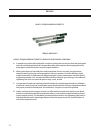
74
Service
USING A TORQUE WRENCH CORRECTLY
TORQUE WRENCHES
USING A TORQUE WRENCH CORRECTLY INVOLVES FOUR PRIMARY CONCERNS:
A. A smooth even pull to the break point is required. Jerking the wrench can cause the pivot point
to break early leaving the bolt at a torque value lower then required. Not stopping when the
break point is reached results in an over torque condition.
B. When more than one bolt holds two surfaces together there is normally a sequence that
should be used to bring the surfaces together in an even manner. Generally bolting is tight-
ened incrementally in a diametrically staggered pattern. Some maintenance manuals specify
a tightening scheme. If so, the manual scheme shall be followed. Just starting on one side and
tightening in a circle can cause the part to warp, crack, or leak.
C. In some cases threads are required to be lubricated prior to tightening the bolt/nut. Whether
a lubricant is used or not has considerable impact on the amount of torque required to achieve
theproperpreloadinthebolt/stud.Usealubricant,ifrequired,ornotifsospecied.
D. Unlike a ratchet wrench a torque wrench is a calibrated instrument that requires care. Recali-
bration is required periodically to maintain accuracy. If you need to remove a bolt/nut do not
use the torque wrench. The clockwise/counterclockwise switch is for tightening right hand or
left hand threads not for loosening a fastener. Store the torque wrench in a location where it
will not be bumped around.


















